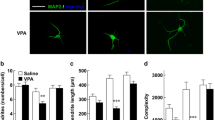Abstract
The amphetamine derivative 3, 4-methylenedioxymethamphetamine (MDMA) has become a popular recreational drug, and has also been shown to cause serotonergic neurotoxicity. This report shows that MDMA impairs brain development in a whole mouse embryo culture. The results of quantitative real-time PCR analysis showed that autophagy-related protein 5 (Atg5) expression is elevated in mouse embryo and neuroblastoma cells after MDMA treatment. This elevated Atg5 expression interferes with the neuronal differentiation of neuroblastoma cells such as SH-SY5Y and PC12 cells. Thus, our results suggest that the use of MDMA during pregnancy may impair neuronal development via an induction of Atg5 expression.
Similar content being viewed by others
References
Baehrecke, E.H. (2003). Autophagic programmed cell death in Drosophila. Cell Death Differ. 10, 940–945.
Campbell, N.G., Koprich, J.B., Kanaan, N.M., and Lipton, J.W. (2006). MDMA administration to pregnant Sprague-Dawley rats results in its passage to the fetal compartment. Neurotoxicol. Teratol. 28, 459–465.
Cole, J.C., and Sumnall, H.R. (2003). Altered states: the clinical effects of ecstasy. Pharmacol. Ther. 98, 35–58.
Degenhardt, K., Mathew, R., Beaudoin, B., Bray, K., Anderson, D., Chen, G., Mukherjee, C., Shi, Y., Gelinas, C., Fan, Y., et al. (2006). Autophagy promotes tumor cell survival and restricts necrosis, inflammation, and tumorigenesis. Cancer Cell 10, 51–64.
Encinas, M., Iglesias, M., Liu, Y., Wang, H., Muhaisen, A., Cena, V., Gallego, C., and Comella, J.X. (2000). Sequential treatment of SH-SY5Y cells with retinoic acid and brain-derived neurotrophic factor gives rise to fully differentiated, neurotrophic factor-dependent, human neuron-like cells. J. Neurochem. 75, 991–1003.
Galineau, L., Belzung, C., Kodas, E., Bodard, S., Guilloteau, D., and Chalon, S. (2005). Prenatal 3,4-methylenedioxymethamphetamine (ecstasy) exposure induces long-term alterations in the dopaminergic and serotonergic functions in the rat. Brain Res. Dev. Brain Res. 154, 165–176.
Hara, T., Nakamura, K., Matsui, M., Yamamoto, A., Nakahara, Y., Suzuki-Migishima, R., Yokoyama, M., Mishima, K., Saito, I., Okano, H., et al. (2006). Suppression of basal autophagy in neural cells causes neurodegenerative disease in mice. Nature 441, 885–889.
Heese, K., Nagai, Y., and Sawada, T. (2004). Nerve growth factor (NGF) induces mRNA expression of the new transcription factor protein p48ZnF. Exp. Mol. Med. 36, 130–134.
Kim, S., Ghil, S.H., Kim, S.S., Myeong, H.H., Lee, Y.D., and Suh-Kim, H. (2002). Overexpression of neurogenin1 induces neurite outgrowth in F11 neuroblastoma cells. Exp. Mol. Med. 34, 469–475.
Kim, H.S., Yumkham, S., Kim, S.H., Yea, K., Shin, Y.C., Ryu, S.H., and Suh, P.G. (2004). Secretin induces neurite outgrowth of PC12 through cAMP-mitogen-activated protein kinase pathway. Exp. Mol. Med. 38, 85–93.
Kim, S.Y., Seo, M., Oh, J.M., Cho, E.A., and Juhnn, Y.S. (2007). Inhibition of gamma ray-induced apoptosis by stimulatory heterotrimeric GTP binding protein involves Bcl-xL down-regulation in SH-SY5Y human neuroblastoma cells. Exp. Mol. Med. 39, 583–593.
Kuma, A., Hatano, M., Matsui, M., Yamamoto, A., Nakaya, H., Yoshimori, T., Ohsumi, Y., Tokuhisa, T., and Mizushima, N. (2004). The role of autophagy during the early neonatal starvation period. Nature 432, 1032–1036.
Lee, M.K., Kang, S.J., Poncz, M., Song, K.J., and Park, K.S. (2007). Resveratrol protects SH-SY5Y neuroblastoma cells from apoptosis induced by dopamine. Exp. Mol. Med. 39, 376–384.
Levine, B. (2005). Eating oneself and uninvited guests: autophagy-related pathways in cellular defense. Cell 120, 159–162.
Levine, B., and Klionsky, D.J. (2004). Development by self-digestion: molecular mechanisms and biological functions of autophagy. Dev. Cell 6, 463–477.
Melendez, A., Talloczy, Z., Seaman, M., Eskelinen, E.L., Hall, D.H., and Levine, B. (2003). Autophagy genes are essential for dauer development and life-span extension in C. elegans. Science 301, 1387–1391.
New, D.A. (1978). Whole-embryo culture and the study of mammalian embryos during organogenesis. Biol. Rev. Camb. Philos. Soc. 53, 81–122.
Pyo, J.O., Jang, M.H., Kwon, Y.K., Lee, H.J., Jun, J.I., Woo, H.N., Cho, D.H., Choi, B., Lee, H, Kim, J.H., et al. (2005). Essential roles of Atg5 and FADD in autophagic cell death: dissection of autophagic cell death into vacuole formation and cell death. J. Biol. Chem. 280, 20722–20729.
Raff, M.C., Barres, B.A., Burne, J.F., Coles, H.S., Ishizaki, Y., and Jacobson, M.D. (1993). Programmed cell death and the control of cell survival: lessons from the nervous system. Science 262, 695–700.
Sumnall, H.R., Jerome, L., Doblin, R., and Mithoefer, M.C. (2004). Response to: Parrott, A.C., Buchanan, T., Heffernan, T.M., Scholey, A., Ling, J., and Rodgers, J. (2003) Parkinson’s disorder, psychomotor problems and dopaminergic neurotoxicity in recreational ecstasy/MDMA users. Psychopharmacology 167(4): 449–450. Psychopharmacology 171, 229–230.
Yamazaki, Y., Tsuruga, M., Zhou, D., Fujita, Y., Shang, X., Dang, Y., Kawasaki, K., and Oka, S. (2000). Cytoskeletal disruption accelerates caspase-3 activation and alters the intracellular membrane reorganization in DNA damage-induced apoptosis. Exp. Cell Res. 259, 64–78.
Zeng, M., and Zhou, J.N. (2008). Roles of autophagy and mTOR signaling in neuronal differentiation of mouse neuroblastoma cells. Cell Signal. 20, 659–665.
Zhu, C., Wang, X., Hagberg, H., and Blomgren, K. (2000). Correlation between caspase-3 activation and three different markers of DNA damage in neonatal cerebral hypoxia-ischemia. J. Neurochem. 75, 819–829.
Author information
Authors and Affiliations
Corresponding authors
About this article
Cite this article
Chae, M., Rhee, GS., Jang, IS. et al. ATG5 expression induced by MDMA (ecstasy), interferes with neuronal differentiation of neuroblastoma cells. Mol Cells 27, 571–575 (2009). https://doi.org/10.1007/s10059-009-0075-2
Received:
Revised:
Accepted:
Published:
Issue Date:
DOI: https://doi.org/10.1007/s10059-009-0075-2




